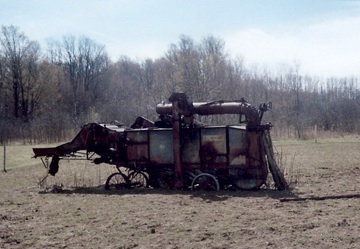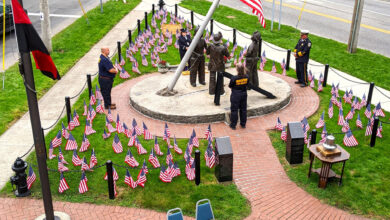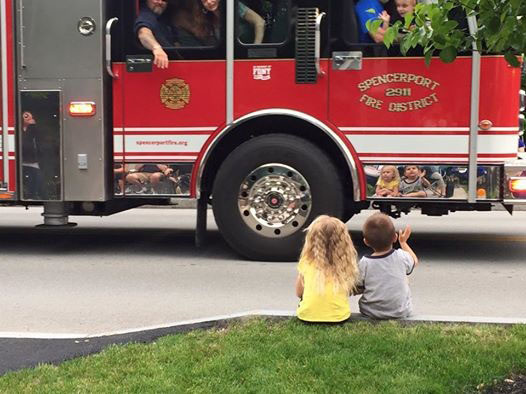Threshers Coming!
by Joe Reinschmidt
 This threshing machine has long outlived its usefulness. Not sold at the auction of other farm equipment about 25 years ago, it remains in a barnyard in the Town of Spafford, Onondaga County, as a symbol of bygone days.Threshing day was an eagerly awaited event by many farm kids in our day. On most small farms it was done by a traveling thresher who charged by the amount of grain that had to be done. Our thresher was Fred Schafer from Vroom Road in Ogden.
This threshing machine has long outlived its usefulness. Not sold at the auction of other farm equipment about 25 years ago, it remains in a barnyard in the Town of Spafford, Onondaga County, as a symbol of bygone days.Threshing day was an eagerly awaited event by many farm kids in our day. On most small farms it was done by a traveling thresher who charged by the amount of grain that had to be done. Our thresher was Fred Schafer from Vroom Road in Ogden.
Preparation for the day actually started weeks before when the standing grain was cut and tied into bundles by a grain binder. The bundles then were loaded onto a wagon, transported to the barnyard and strategically piled so there was room for the threshing machine to fit near the stacks but also close to the granary where the shelled grain was to be stored. Once done, the thresher was notified and a tentative day established. Neighbors who were going to help were also informed, but then it was a waiting game dependent on the weather and mechanical breakdowns.
Only on the day you saw the thresher coming down the road could you assume it was “the” day. Fred had a large Huber tractor and all of us kids secretly wished that we could have one like it someday. We took turns looking down the road and each of us wanted to be the first to see him and then shout for all to hear, “Threshers coming!”
Fred himself was an average-sized man with skin darkened by being outdoors and the cumulative effect of daily exposure to the dust and chaff of the grain. He had a very mischievous twinkle in his eye and a dry sense of humor. I think he had a dry throat too because he rarely refused a glass of good hard cider, which was a staple at our place, as well as a hearty noonday meal my mother, Anna, had prepared for him and all the workers.
Fred’s job was to keep the machine humming. My father, Joe, usually threw the bundles of grain into the top of the machine which another man threw up to him from the stack, and yet another man would convey the shelled grain from the chute on the machine into the granary. We kids helped pack down the straw stack which was created by the stems of the grain that were blown out the large trunk-like pipe that extended about 20 feet from the thresher. The straw was used as bedding for our animals throughout the year. We also had to keep cold water or other beverages available
There was an expression used by many a mother and grandmother that misbehaving children would be “threshed” within an inch of their lives. Seeing a threshing machine in operation gave real meaning to that warning. With all the belts and pulleys turning, the thing wheezed, shook, belched dust from many areas and all but drove off on its own.
As with most farm tasks, we quit when the work was done, even if it wasn’t finished until dusk, rather than start over in the morning. The eagerly awaited event was now thankfully done for another year. We also didn’t have to feed the chickens, ducks and geese for a few days since they scratched through the chaff where the thresher was parked and found plenty of grain that had escaped from the machine.
But then came the time that a neighbor acquired a “combine,” so named because it cut and shelled the grain in one operation in the field, which reduced the planning and work that traditional threshing involved. We were excited about that, too, but didn’t realize until sometime later that Fred and his machine would no longer be eagerly awaited and the cry of “threshers coming” would never again ring out at our farmstead.



